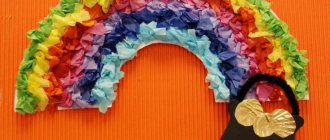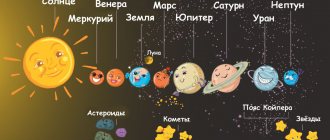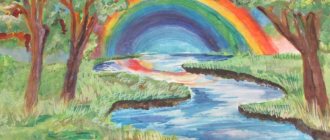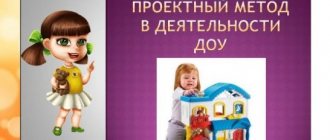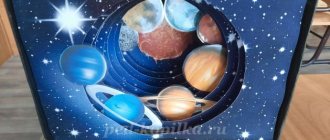Poems about rainbows
When telling children what a rainbow is, include in your story the poetic inspiration of poets of all times and peoples, inspired by a multi-colored arc in the sky.
* * *
It got caught on a cloud and hangs above us. She has seven different stripes, We counted them!
Who will answer the question: What is this? This is a miracle - who brought it? How beautiful!
You guessed it! Yes, yes, yes, it's a rainbow-arc!
The sun and the rain played and the toy was lost, and now for everyone it is visible from the blue skies!
Rainbow
Alexander Byvshev
A multi-colored rocker hung above the ground. Spring rays are pouring, Rooks are bathing in them.
And the meadows, washed by the water of the long-awaited rain, Whisper joyfully: “Hello, rainbow-arc!”
Rainbow
Inna Gamazkova
The rooster saw a rainbow: - What a beautiful tail! The ram saw a rainbow: - What a high bridge! / And the horse looks at the rainbow: - The horseshoe is great... The river looks into the rainbow: - And there is a river in the sky?
Rainbow
Vladimir Stepanov
A rainbow hung in the spring sky, looking cheerfully from the sky to the earth. We smiled joyfully in response: - Rainbow - rainbow, color - overexposure.
The rainbow did not hang in the sky for long, It did not look from the sky to the earth for long: It melted... What did it leave as a souvenir for everyone?
Red poppies, Yellow sand, Green light on a leaf on a branch.
The purple beetle warms its sides, the blue splashes the river into the banks.
The forests are warmed by the orange sun, and the starling has blue... eyes.
* * *
Inna Kulskaya
The sky is belted with a rainbow-arc. And the golden sun looked through the clouds.
Bright rain fell on the asphalt, jumping onto my hands, onto my shoes.
* * *
Rainbow - rainbow, multi-colored ribbon! The rainbow has seven colors, all colors are noticeable! You are always elegant, ringing, like a song. It's good to ride on the rainbow, it's fun!
Komovskaya N.
* * *
- Rainbow, tell me, What power united all your colors? “This is friendship,” Rainbow answered. — The colors in the rainbow are friends, Guys. The Rainbow is rich in strong friendship, radiating a clear light.
Bayramov N.
* * *
Joy, you see, what a joy! There's a rainbow in the sky! Colors of wondrous beauty near the celestial RA-arc. Seven colors came together, like notes in a friendly song. Here is the Sun in yellow, the green of all the forests of the planet, the blue of the heavenly depths, purple dreams. Who entrusted the staff of music to all colored pencils?
Vita E.
* * *
In the sky the rainbow shines and glitters, As if the passage through it is open to us. A multi-colored ray descended from the sky, The forest shines in the beautiful rainbow dust.
The foliage shimmers like an emerald, Reflections of the rainbow are visible here and there, The forest plunged into a fairy tale and became silent, It wants to hold on to the wonderful moment.
Science has long explained everything to us, but it is not possible to fully understand nature. Seeing a rainbow in the blue sky, We dream that these are symbols from the outside.
Delight takes us into a sky-high flight, Perhaps the answer to a miracle awaits there. The rainbow shines for us, fresh and good, The bright colors make our eyes glow with happiness.
Mordovina I.
* * *
How unexpectedly and brightly, In the damp blue of the sky, An airy arch rose in its momentary triumph! She stuck one end into the forests, with the other she went behind the clouds - She grabbed half the sky and was exhausted in the heights.
Oh, in this rainbow vision What bliss for the eyes! It is given to us for a moment, Catch it - catch it quickly! Look - it has already turned pale, Another minute or two - and then what? Gone, somehow it will go away completely, What you breathe and live with.
Fyodor Tyutchev
* * *
There is thunder and thunderstorm in the sky. Close your eyes!
The rain is over. The grass is shining, there is a rainbow in the sky.
Hurry, hurry, run out the door, barefoot across the grass, jump straight into the sky.
Okay, okay! Along the rainbow, along the iris, Along a colored arc on one leg. Down the rainbow on horseback And to the ground somersault!
Samuel Marshak
Types of rainbow
Scientists distinguish different types of rainbows depending on the size of the drops, the intensity of light and the height of the Sun above the surface of the earth.
Sometimes you can see a second rainbow, less bright, around the first:
This occurs when the sun's rays are reflected inside the droplet twice before reaching the surface. The intensity of the light flux weakens, and the multi-colored strip appears “inverted” - the purple color appears at the top. As a result, a double rainbow appears in the sky. The celestial sector between two arcs usually has a darker hue than outside them. This area is called the Alexander Stripe, named after the Ancient Greek philosopher Alexander of Aphrodisias, who first described this effect in the 2nd century AD. e.
A triple rainbow is much less common in nature:
This is possible when the rays are reflected three times inside the drops. In this case, a third-order arc is formed, weaker than the previous two.
The sun's ray passing through large drops is weakened and creates a more diffuse spectrum. The color and brightness of the Sun changes at dawn and dusk. Sunset light travels the maximum distance to the observer's eyes, which is accessible to the long-wavelength part of the spectrum. Therefore, a red rainbow is found - with a predominance of red and orange stripes:
And if rain, rainbows and the Sun are a familiar combination observed most often, then in the absence of the Sun or rain, an atmospheric phenomenon can take on the most unusual forms.
Unusual species
Unusual and rare types of rainbows include:
- lunar;
- foggy;
- fiery.
A lunar rainbow, otherwise called a night rainbow, is much less common in nature than the usual daytime one. It occurs during the full phase of the moon in moist air. The Moon should be in a clear sky less than 42° above the horizon, and the observer should be between the Moon and the rain. Similar phenomena are known over waterfalls:
The human eye's color-detecting receptors are inactive in low light. Therefore, a night rainbow is perceived by vision as white, in contrast to the colorful daytime one. However, you can see the entire spectrum in a long exposure photo.
For a fog rainbow instead of rain and sun, a combination of fog with sunlight or moonlight is required. Since the drops of moisture in this case are very small (their radius is no more than 0.05 mm), the light in them cannot always be scattered in the form of a spectrum. This phenomenon looks like a halo of white color, which is why the phenomenon is sometimes called a white rainbow. In this case, the outer contours of the arc can be painted purple and orange:
One of the rarest weather phenomena is a fire rainbow . It looks like a horizontal arc against the background of light cirrus clouds. That is why it is also called a rainbow with clouds. Thanks to the huge radius, the arc line appears straight, extending parallel to the horizon for hundreds of kilometers:
For its appearance, three factors are necessary:
- cirrus clouds in the sky;
- flat hexagonal ice crystals arranged horizontally in clouds;
- the height of the Sun is at least 58° above the horizon.
The latter condition makes it impossible to observe this phenomenon from the earth's surface at latitudes below 55°, where the Sun does not rise so high. The situation can be corrected by climbing a high mountain.
The ice crystals should lie horizontally in the air, which is quite rare. The sun's rays penetrate through the side walls of the crystals and, being refracted, exit through the lower horizontal face. Clouds in the rays of the spectrum flash with rainbow light.
A fire rainbow is considered a type of halo.
How does a rainbow appear?
The formation of a rainbow occurs due to the refraction and reflection of a ray of light by drops of liquid. Each drop deforms the beam in its own way, reflecting different colors. Refraction is accompanied by the deviation of a certain color by a different angle. Red light has the smallest angle.
White light passing through the droplet separates it into its spectrum components. This is why the human eye sees a multi-colored arc. The shape of a rainbow is determined by the characteristics of light refraction.
In most cases, a primary rainbow occurs. Formed as a result of one reflection of rays. Secondary occurs less frequently. Externally it has a less intense color. Occurs after double reflection of rays. Tertiary occurs extremely rarely in nature. A total of 5 cases of observation of this type were recorded. A tertiary version can be easily created in a laboratory setting. Scientists can also create higher order variations, up to 200.
Scheme of phenomenon formation
Interesting Facts
- The perception of the spectrum differs among different peoples. According to Newton's classification, blue and dark blue are replaced by blue and its darker shade - indigo. Modern Englishmen distinguish 6, not 7, primary colors: they do not divide blue into dark or light shades. And in the Japanese tradition, green is present only as a shade of blue.
- A third-order (triple) rainbow is far from the limit. The human eye simply does not perceive multiple, but weaker reflections of spectra. In laboratory conditions, using a laser setup, researchers obtained a rainbow of order two hundred.
- Typically perceived as an arc, the shape of a rainbow can be circular when viewed from a great height, such as from an airplane:
A circular rainbow results from the spherical shape of the drops. The reflected light forms a circle, the center of which is in line with the observer's eye. Therefore, a person standing on the ground cannot see the lower half of the arc.
A rainbow is just an optical effect, explained by science. It is not located in a specific place and, like the horizon line, cannot be approached. What each of us sees depends on the place of observation and our position relative to the Sun or other light source.
What time of year does a rainbow occur? Almost any time. It's just that in winter the moisture is replaced by ice crystals. Therefore, you can always observe this miracle of nature when there is a strong light source and weather conditions for its transformation into a spectrum.
Progress of the experiment: For the experiment we will need:
triangular transparent prism.
I took the prism in my hands and brought it to the window, the sun's rays began to pass through it, thanks to which a rainbow appeared .
Thanks to these experiments, we can conclude that our hypothesis was confirmed. Rainbow can be obtained at home.
Conclusion: the sun's rays, passing through a prism (as in the case of water, are refracted, that is, decomposed into their component parts - seven colors of the rainbow .
Experiment IV
Similar phenomena
There are similar phenomena that are often confused with the rainbow itself.
Halo is a frequently encountered atmospheric optical effect. Looks like a round rim around the Sun or other light source. May occur due to the presence of ice crystals in cirrus clouds at high altitudes. The variability of subspecies is high: ring, inverted, antelelic arches, solar pillar.
Halo
One type of halo is called a parhelium. Appears when sunlight is refracted by anisotropic ice crystals. The observer perceives it as a rainbow spot not far from the Sun. A similar phenomenon occurs on moonlit nights and is called parselena. Parselena has a different color - the upper part is red, the lower part is blue.
The zenith arc is similar to an inverted rainbow arc. Also a type of halo. Occurs when light is reflected from cirrus clouds.
How to make your own rainbow
To make a rainbow yourself, a person will need:
- bowl of water;
- white sheet of cardboard;
- small mirror.
The experiment is carried out in sunny weather. To do this, place a mirror in a regular bowl of water. The bowl is positioned so that the sunlight falling on the mirror is reflected on a sheet of cardboard. To do this, you will have to change the angle of the objects for some time. By catching the tilt, you can enjoy the rainbow.
The fastest way to make your own rainbow is to use an old CD. Change the angle of the disk in direct sunlight and get a clear, bright rainbow.
Kinds
One of the most common species is the double rainbow. Appears as a result of the simultaneous presence of the primary and secondary types in the sky. Theoretically, each type of phenomenon is double, but the color saturation of the second can be low and barely noticeable. Occurs due to double reflection within water droplets. A triple rainbow is similar to a double rainbow in its formation mechanism. The only difference is the additional arc.
Unusual types of rainbows include lunar ones. It appears on moonlit nights. Looks like a white arc. Due to the lack of light, human vision does not see it as colorful as during the day. The brighter the light reflected by the Moon, the better the eye will be able to see the shades.
A fog rainbow occurs during light fog. Light is refracted, then scattered in small drops of water. The intensity of the colors is low - outwardly the phenomenon is similar to the lunar appearance.
Fire rainbow is a rare optical effect. It looks like a horizontal spectrum of colors among the clouds. Occurs when ice crystals are horizontal in the cloud. Usually observed in mountainous areas.
A red rainbow appears at dawn after rain. Looks like a single red arc. Also called monochrome.
A circular rainbow often stands out among the species. In fact, each type of phenomenon has the shape of a circle, but it is not possible to see it completely from every angle. The solid circle is clearly visible from a tall building or airplane.
Circular (ring) variety
Conditions for a rainbow to occur
To see a rainbow on the street, two main conditions must be met:
- rainbows appear more often if the sun is low on the horizon (sunset or sunrise);
- you need to stand with your back to the sun and your face to the passing rain.
A multi-colored arc appears not only after or during rain, but also:
- watering the garden with a hose;
- while swimming in water;
- in the mountains near a waterfall;
- in the city fountain in the park.
If rays of light are reflected from a drop several times at the same time, a person manages to see a double rainbow. It is noticeable much less often than usual, the second rainbow is noticeable much worse than the first and its color is a mirror image, i.e. ends in purple.
History of the study
The study of the phenomenon began several centuries BC. The ancient Greek scientist Aristotle closely studied the phenomenon. The description of the atmospheric miracle in his works is consistent. Elements of his research were used by other scientists for several centuries.
The ancient Roman philosopher Seneca the Younger collected several theories of the origin of the rainbow in his books. The philosopher noticed that it appears opposite the Sun and in splashing water. He also mentions the rainbow colors created when light passes through glass rods. As a result, Seneca came to several versions of the origin of a bizarre atmospheric phenomenon in nature. According to the first version, the phenomenon is created by a combination of sunlight and drops of liquid. According to the second, light is reflected by clouds shaped like a concave mirror.
Seneca's theories were developed in the works of the Arab physicist Ibn al-Khatam. The scientist suggested that rays emanating from a distant light source are reflected at a point on the axis of a concave mirror. The human eye acts as a point on the axis of the mirror.
An accurate physical description of the phenomenon appeared in the works of medieval European scientists. For example, books by Mark Antony de Dominis and Rene Descartes. Isaac Newton substantiated the theory of the origin of color phenomena. Additionally, the scientist identified 7 component colors of the spectrum, describing the dispersion of light.



